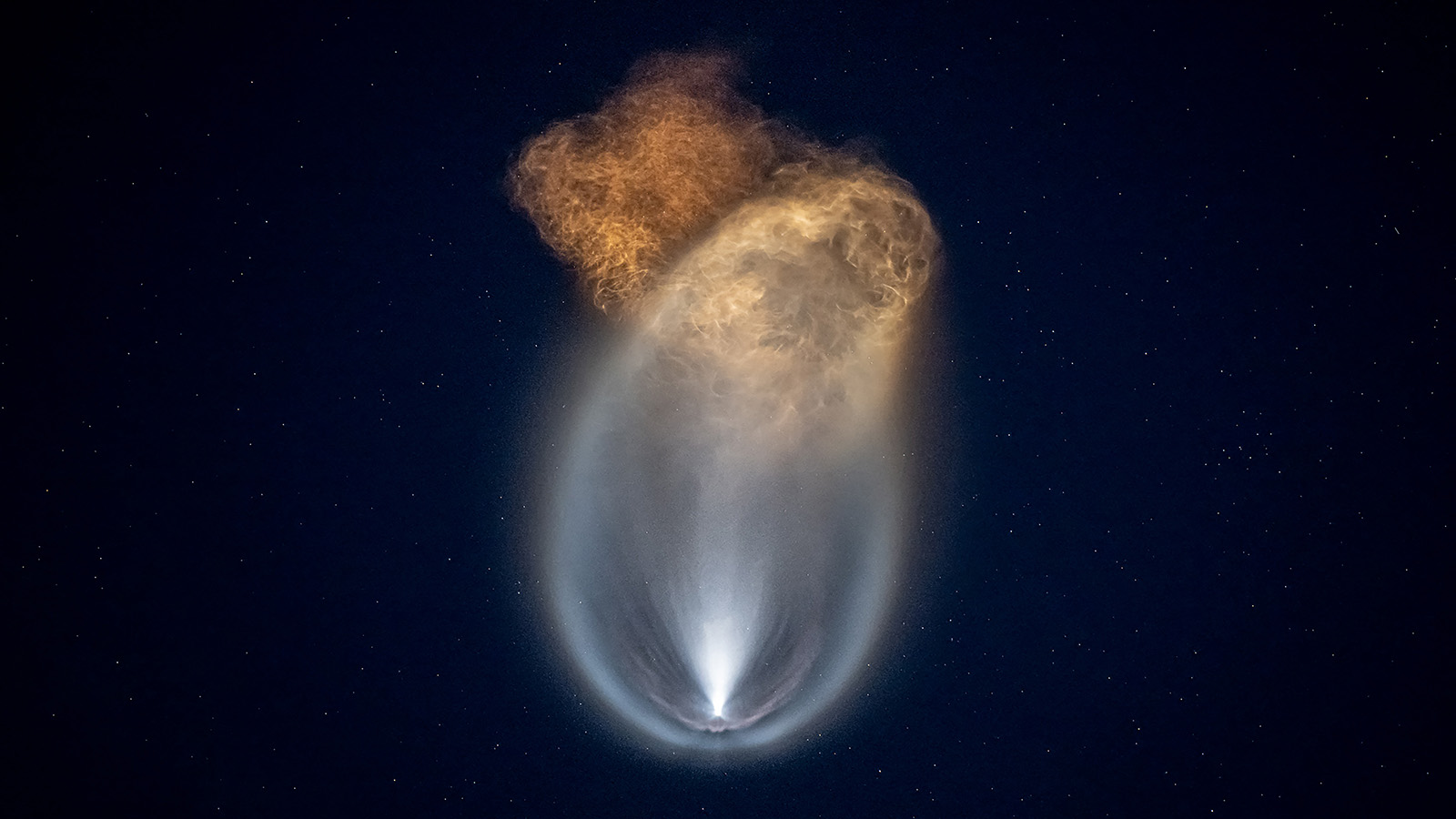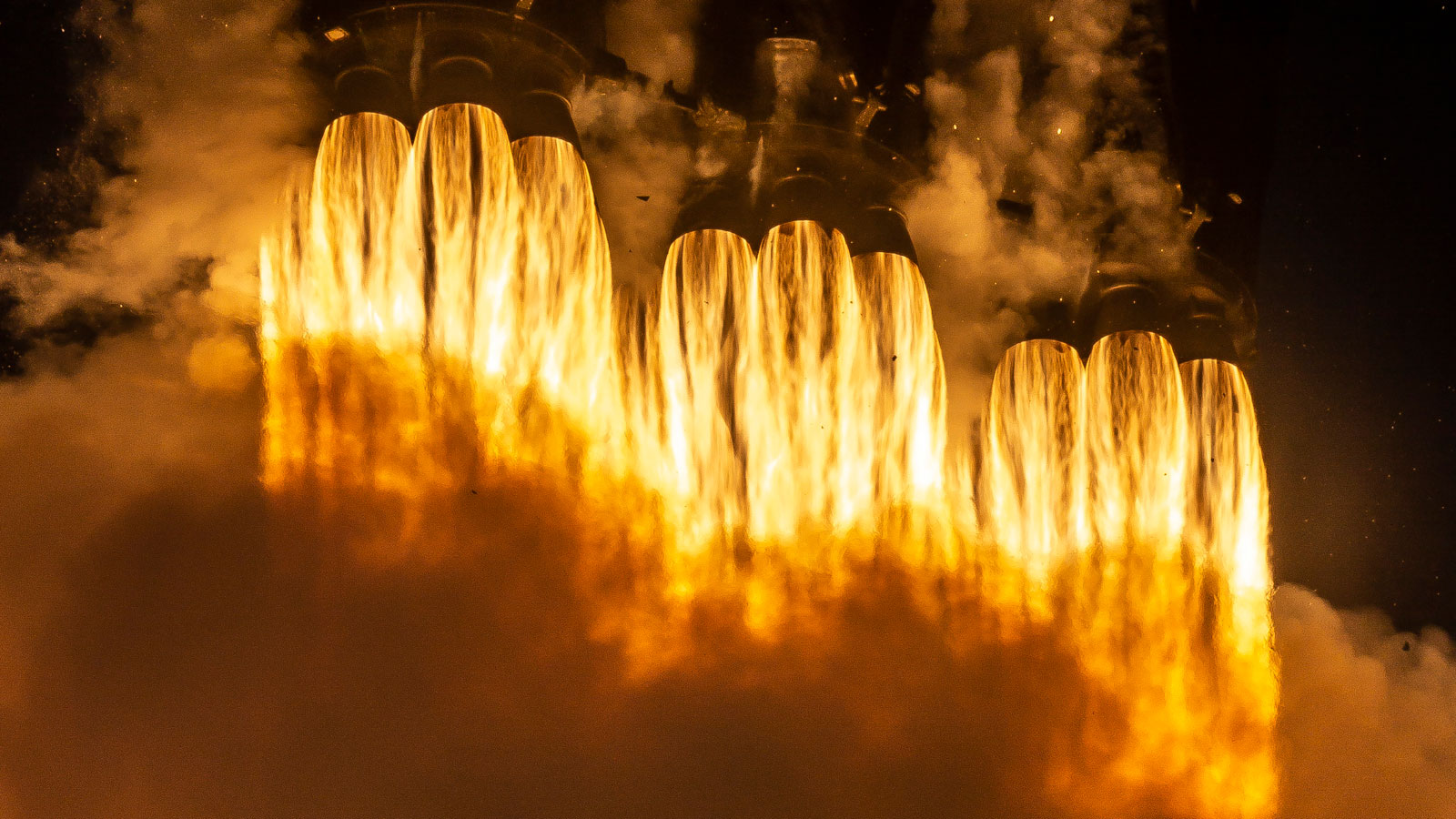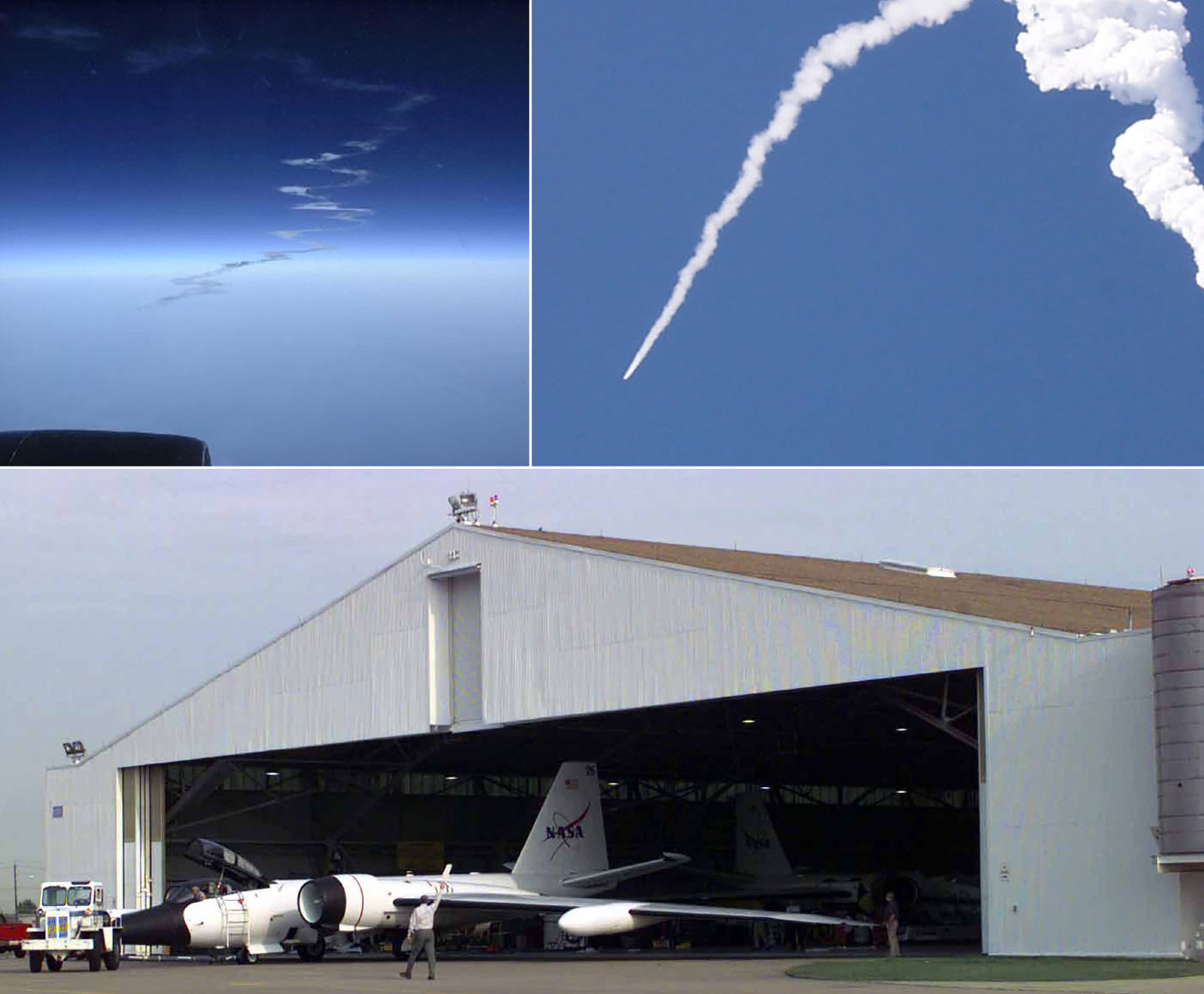Stay Up to Date
Submit your email address to receive the latest industry and Aerospace America news.
Moving about by trains, automobiles and aircraft began without consideration for the environmental effects of the emissions from these machines. Is humanity about to repeat this disregard, this time for transportation to space? Perhaps, but it doesn’t have to be that way. Alyssa Tomlinson tells the story.
With his ride to suborbital space fresh on his mind, Blue Origin founder Jeff Bezos sat in an old-fashioned wooden chair at Washington National Cathedral in November and let his latest accounting of our “fantastical” future echo through the chamber. Millions of people will live and work in space “with rivers and forests and wildlife,” he said, according to a video of the event. Earth will become a “national park” with power beamed down from vast “solar power generation stations.” Most “heavy industry” would be done off planet. “This place is special,” Bezos said of Earth. “We can’t ruin it,” and the solution is for humanity to expand into space. Earth can support 10 billion people, he said, whereas the solar system can support a trillion.
Pressed by interviewer Adi Ignatius of Harvard Business Review about the technology this vision would require, Bezos said the millions would need to be shuttled to “rotating” habitats inside reusable spacecraft as easy to maintain and operate as airliners. A step toward this new mode of transport will be his company’s New Glenn space launch vehicles, he explained.
Although Bezos did not raise it during the cathedral appearance, getting millions of people into space with New Glenn or other rockets would require a massive increase in launches over the approximately 230 conducted by all launch operators combined in 2021, a tally that includes the year’s history making suborbital tourist flights. Not to be outdone, Bezos’ rival Elon Musk of SpaceX has proposed launching two of the company’s planned, 39-engine Starship rockets every two weeks to colonize the surface of Mars. Richard Branson’s Virgin Galactic company, meanwhile, plans to launch its Virgin SpaceShips on tourist flights at a rate of 400 flights per year from multiple spaceports.
As experts stepped into the limelight to question whether such visions could ever become reality, environmental and planetary scientists began to ponder whether those visions ever should. This space launch revolution, if it is indeed upon us, would at this writing occur with only rudimentary knowledge of the kinds of rockets that will be fielded next, their emissions and the environmental consequences of such a massive increase in launches. A special concern is the effect of potentially thousands of rockets racing through the stratosphere annually, a topic that only one company referenced in this story, Blue Origin, would discuss by pointing us to independent research.
“The technology is changing unpredictably, and so all these changes present uncertainties that prevent us from fully understanding how rocket emissions affect the stratosphere,” says Martin Ross, an atmospheric scientist with the Aerospace Corp., a federally funded research and development company based in California.
Ross is among those who want the United States and others to fund sampling flights through rocket plumes to measure their emissions and then quantify the potential impact of various kinds of rockets. Next, regulators, and perhaps benevolent billionaires, could set limits on the number of launches per year or shift to fuels that emit fewer pollutants, or, ideally, do both. Right now, scientists lack the emissions data that they need to push for such regulations or voluntary steps.
Public enemy No. 1: Black carbon
As far as the climate is concerned, the main issue is not the carbon dioxide gas in the emissions of some rockets. Darin Toohey, a University of Colorado Boulder atmospheric and oceanic sciences professor, and others in the field have found that the overall impact of rockets on climate change by way of carbon dioxide emissions is negligible, and likely would remain so even with a significant uptick in launches. When it comes to rockets, the more pressing concern is their soot, known to scientists as black carbon, which also has a significant warming influence.
These clumps of carbon particles are left in the wakes of rockets that burn kerosene (SpaceX Falcon 9 and Heavy) or synthetic rubber (VSS Unity and the solid rocket motors of NASA’s Space Launch System), and possibly methane (Starship and New Glenn), which little research has been done on.
The clumps float and bounce in the stratosphere, absorbing shortwave light from the sun and heating the surrounding air, until enough water molecules glom onto them to make them heavy enough that they fall as precipitation, sometimes as a grayish snow.
“The stratosphere is the great equalizer,” Toohey says. If enough black carbon soot accumulated there, it would spread, and that spreading could disrupt weather patterns on top of the changes already underway due to the warming climate.
“Weather is essentially just the movement of water and heat from one place to another,” Toohey explains. “When you put black carbon in the upper atmosphere, you change the structure of the heating of the atmosphere and that changes how heat and water are distributed.”
People in parts of the world — including those already characterized by harsh climates — might experience the effects disproportionately than residents of other parts of the world, by way of more frequent severe weather events. This also means that the impacts of black carbon emissions wouldn’t be confined to the immediate area in which they are emitted, such as a launch site. Instead, the impacts could be felt most in areas that are hundreds or thousands of kilometers away.
Ross says that with the launch increases so far, the stratosphere remains a relatively clean place, the greatest sources of black carbon in most of the
stratosphere being the occasional volcano or major wildfire that catapults ash to high altitudes. For the highest region of the stratosphere above 20 km, spaceflight is the only source of black carbon.
Ozone
The stratosphere is also home to the ozone layer, a blanket of molecules consisting of three oxygen atoms that form when solar ultraviolet light strikes oxygen molecules.
In 2020, a research team led by Eloise Marais, an associate professor in physical geography with University College London, ran models of rocket launches conducted the year before. Along with black carbon, they catalogued emissions including nitrogen oxides and, exclusively from solid rocket motors, particles of alumina and chlorine. These emissions could be poised to undo some of the ozone recovery of the past three decades — even if the total number of flights per year falls short of current plans. Alumina is of particular concern because it catalyzes a chemical reaction in which chlorine atoms bond with ozone molecules, converting them to oxygen. The heat trapped in the stratosphere from black carbon could in turn speed up the rate of these reactions.
The 1987 Montreal Protocol on Substances that Deplete the Ozone Layer, the multilateral environmental agreement that regulates the production and consumption of nearly 100 ozone-depleting substances, largely healed the hole in the ozone layer that had emerged over Antarctica. The international treaty does not address the potential impact of black carbon emissions. Without international regulations in place — such as limits on black carbon emissions — the space industry can largely operate unchecked.
Coping with soot
In Ross’ view, there would be a workable solution even if companies continue to rely on kerosene, methane and synthetic rubber-fueled engines or other black carbon-emitting technologies. The simple act of varying where launches occur or staggering launch schedules to give the soot time to fall out of the sky could minimize environmental damage.
But views vary about how long soot stays around. Black carbon is a “short-lived climate pollutant with a lifetime of only days to weeks after release in the atmosphere,” says the U.N.-affiliated Climate and Clean Air Coalition. Toohey, the Boulder professor, says smaller particles likely linger longer, three to five years on average.
With more data to determine the precise amount of black carbon particles emitted by each type of launch vehicle — and just how long those particles could remain in the stratosphere — scientists could help formulate guidelines for staggering launches in order to minimize overall environmental impact. Ross and Toohey are not suggesting waiting three to five years until all particles are gone.
“Let’s say that Jeff Bezos wants to put a lot of rockets up into space in order to move the material he needs to build his industries and relocate dirty industries,” Toohey says. “I have no problem with that — so long as it doesn’t all happen at once. The strategy has to center on how to do it sustainably.”
Adds Ross: “That’s why future measurements and modeling are needed and warranted.” He wants to create a detailed “black carbon emission index” for various kinds of rocket propellants and engines. “We’re largely guessing at that right now,” he says. “We have the instruments to carry out the measurements, we have the platforms we need, we know how to do it. What’s lacking is funding. There doesn’t seem to be a central point of energy or power to make this happen, and I think that’s because so much of space is commercialized now.”
Hydrocarbon alternative
Of course, there might be one way that Bezos and Musk could get their millions in space without causing climate and weather disasters: Shift to non-hydrocarbon propulsion. Blue Origin’s BE-3 engines — one of which powered Bezos’ July trip to the edge of space atop the New Shepard rocket — are fueled by liquid hydrogen and oxygen, and yield water vapor as the exhaust. Based on Ross’ research, Blue Origin calculates that the climate forcing from a single BE-3PM would be 750 times less than that from a hybrid engine — the kind flown by space tourism rival Virgin Galactic.
Ross says the lack of current data means he couldn’t calculate climate forcing more finely than an order of magnitude, meaning an error factor of 10 times.
Why hasn’t Blue and the industry shifted to these cleaner hydrogen-oxygen engines? Toohey surmises that some companies might hesitate to shift to such engines due to perceived safety concerns about handling highly combustible liquid hydrogen and liquid oxygen. On top of that, hydrogen is difficult to store and kerosene engines are cheaper to make, he says.
The space shuttle orbiters were propelled by hydrogen-and-oxygen fueled Aerojet Rocketdyne RS-25 engines, the same kind that will power NASA’s SLS. But like the shuttles, each SLS will need added thrust from a pair of soot-producing solid rocket motors.
Even without solid fuel, it’s not like liquid hydrogen and oxygen would have no impact on the atmosphere if launched in great numbers. Water vapor emissions can still form clouds in the upper atmosphere and thereby impact weather patterns as more and more flights take off, Toohey says. Still, he thinks the technology offers significant environmental benefits by eliminating soot.
Bezos, in his cathedral appearance, said that each passenger he sends to the fringes of space comes home an “ambassador” committed to saving Earth. “We sit here and the atmosphere looks so big and this planet looks so big,” he said. “But up there, what you see is the immense blackness of space” and “this tiny little cradle.”
Without new technologies and regulations, will the net effect of such epiphanies be a positive one for the health of the planet? Marais, the University College of London associate professor, is among the doubters.
“When you look at the space tourism industry, it’s a bit shocking because you realize that it’s the top 1% [of income-earners] who will be able to go into space to essentially take expensive selfies,” she says. “What’s important is that we have to work together as an international community to develop policies that can at least mitigate the impact that this will have on the atmosphere.”
Sampling rocket plumes
For the scientists calling for further study of rocket engine emissions, a potential blueprint already exists: ACCENT, short for Atmospheric Chemistry of Combustion Emissions Near the Tropopause. Created to gauge the impact of rocket launches on ozone depletion, this NASA-Air Force program sent a research aircraft through the plumes of approximately a dozen launches in the late 1990s and early 2000s.
Prior to each launch, two NASA pilots ascended to about 50,000 feet in a WB-57 aircraft, loitering about 80 kilometers from the launch pad. About five minutes after confirmation of liftoff, they made multiple passes through the white rocket plume, the hollow tube-shaped probes on the plane’s nose gathering samples. About a dozen passes were made through the plumes over a two-hour span after launch to measure how emissions including the black carbon particles dispersed in the stratosphere over time. The ACCENT program gathered emission samples from the plumes of five rocket designs: The Delta II, Atlas II, Athena, Titan IV and the space shuttle orbiters.
The findings? The solid rocket motors and kerosene engines were depositing fewer particles in the stratosphere than models had predicted, findings the ACCENT group presented to the Montreal Protocol. —Cat Hofacker
About Alyssa Tomlinson
Alyssa has covered unoccupied aircraft systems and transportation engineering for higher education publications.
Related Posts
Stay Up to Date
Submit your email address to receive the latest industry and Aerospace America news.







